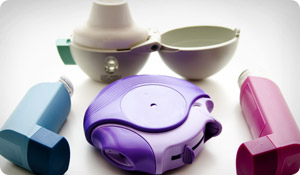
Most asthma inhalers will either give you long-term control to manage your condition or short-term relief to address presenting symptoms.
Long-Term and Short-Term Medication Types
Many asthmatics need a combination of both types of medicine as part of their overall asthma management strategy. Here are more specifics about each of these asthma inhaler types:
Long-term control inhalers contain corticosteroids or glucocorticosteroids (a type of steroid) that you inhale into your airways to manage asthma on a long-term basis. While long-term inhalers don't help with symptoms once you're experiencing an attack, they can help over the long-term by preventing and reducing inflammation and related swelling that can make it difficult to get air in and out of your lungs. It's important to understand that in order for inhaled steroids to be effective, they need to be used every day—even when you aren't experiencing symptoms.
Also called rescue inhalers, fast-acting relief inhalers contain a bronchodilator that works to relax the muscles in your airways to keep them from going into a spasm—which is essential for immediately relieving an asthma attack. While it's important to always have your fast-acting relief inhaler handy in case you need it, if you find that you're relying on this type of inhaler frequently, it probably means that your asthma isn't well managed. This should prompt you to your doctor to learn how to get a better handle on your condition.
Inhaler Delivery Methods
In addition to the type of medication your inhaler contains, the way it's delivered can also make a difference. The two most common styles of asthma inhalers used today to deliver both long-term control medications and fast-acting relief medications include a metered dose inhaler and a dry powder inhaler.
A metered dose inhaler uses a burst of aerosol to propel a measured dose of the medication out of a small-pressurized canister and into your lungs. If you have trouble coordinating the medicine release with your breathing, you may need the help of a spacer. It allows you to spray the medication particles into a little tube attached to the inhaler so you can breathe in more easily.
Dry powder inhalers are less common because they can be more difficult to use for some asthmatics. A dry powder inhaler requires you to activate the medication (often using a button, level, or dial) by taking a deep, quick breath to draw the medicine into your lungs. The downside to this method is that it requires fast inhalation and this format doesn't work with a spacer, which makes it less appealing for some patients.
New Asthma Inhalers to Come
New types of inhalers are constantly in the works. Be on the lookout for what's new on the market and speak to your doctor about those currently available.
Sources:
American Academy of Asthma, Allergies and Immunology. "Inhaled Asthma Medications: Tips to Remember." Web. 15 Feb. 2012.
http://www.aaaai.org/conditions-and-treatments/library/at-a-glance/inhaled-asthma-medications.aspx
BBC News. "Health Asthma Treatment Breakthrough." Web. 17 Feb. 2012.
http://news.bbc.co.uk/2/hi/health/287021.stm
The Mayo Clinic. "Asthma inhalers: Which one's right for you?" Web. 14 Feb. 2012.
http://www.mayoclinic.com/health/asthma-inhalers/HQ01081





